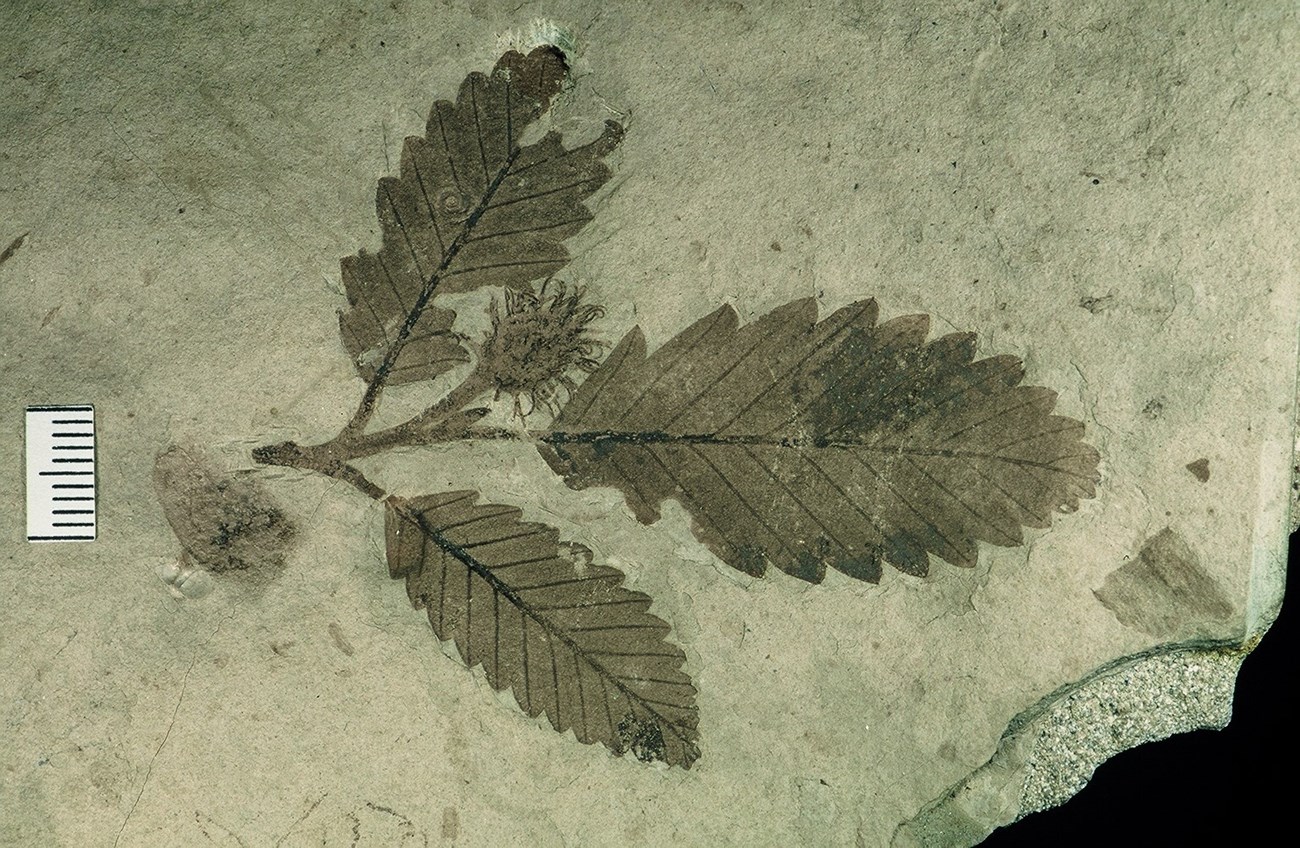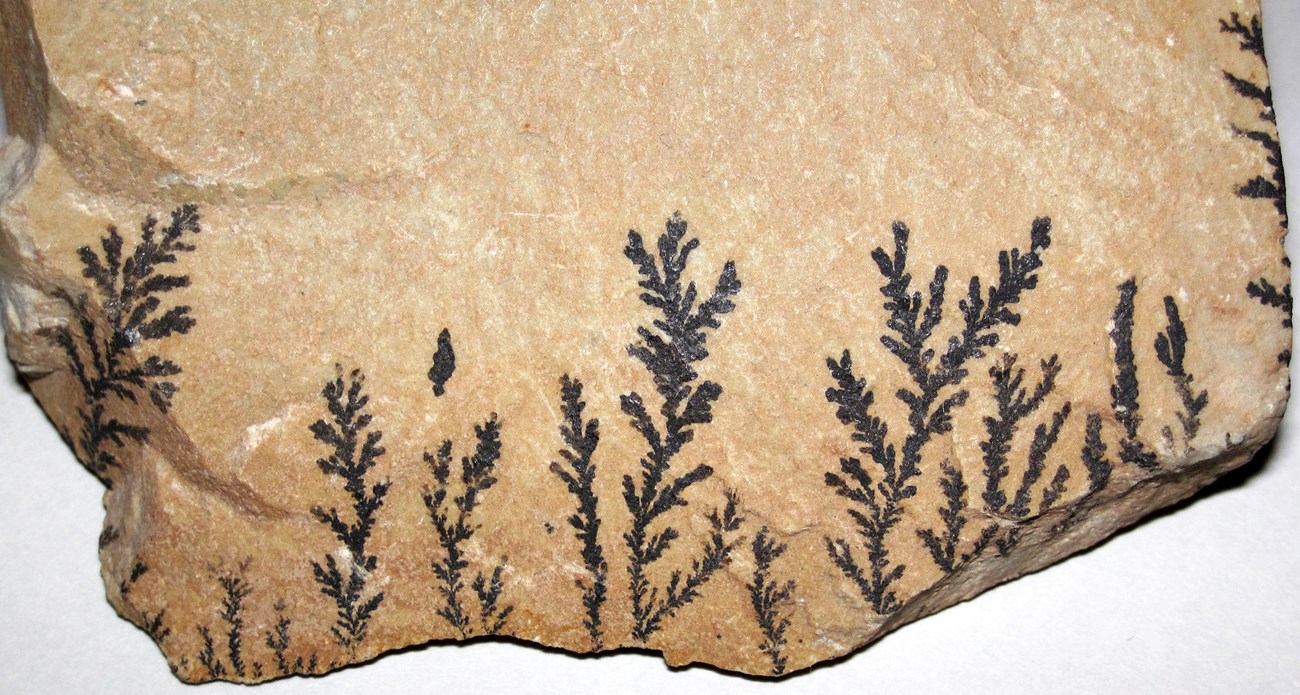Introduction
Fossils provide information about plants, animals, and microorganisms that have lived on Earth throughout geologic time. What a fossil is can be highly variable. Fossils range from the bones of giant dinosaurs like Apatosaurus to the remains of microscopic organisms or grains of pollen. Fossils also include hefty chunks of petrified wood and the trails that trilobites left on the seafloor more than 500 million years ago, as well as insects entrapped in amber and ancient animal dung. The coiled shells of nautiloids, invertebrate predators who ruled the oceans of the Late Paleozoic, leaf impressions, shark teeth, and mammoth tusks are other examples of fossils found in national parks.
Definition
The word “fossil” has a different meaning in everyday conversations than in its strict scientific usage. In casual conversation, anything that is old, out-of-date, or old-fashioned may be called a fossil. Not so within the fields of paleontology and geology.
The scientific definitions are much more narrow and specific. Although scientific definitions may vary in their exact verbiage, they all restrict the usage of the term to the remains, traces, or imprints of past living organisms found in the geologic or rock record.
The National Park Service uses a specific definition to concisely describe what a fossil is:
Evidence of life preserved in a geologic context.
This definition has two major parts:
-
Evidence of life
-
Geologic context
The evidence of life part of the definition means that fossils must be either the remains of a living organism or some sort of trace or mark of an organism. Often the remains of the fossil organism have been altered through chemical or physical processes that took place during fossilization, like the minerals in bone being replaced by silica or the recrystallization of minerals in a shell. More rarely, the remains are virtually unaltered as sometimes happens when an animal carcass becomes desiccated in a dry cave. Traces include a variety of footprints, tracks, trails, burrows, and other marks left by organisms while they were alive.
Geologic context is the rock or other sedimentary deposits in which a fossil is present. Fossils may be present in sedimentary rocks that were deposited in a variety of environments, including marine, coastal, tidal flats river channels and their floodplains, lakes, and other. More rarely is the evidence of life preserved in volcanic rocks. Fossils may also occur in caves and soils.
Geologic content is important because it provides critical information about the environments and conditions that the plants and animals lived it. Examining features in sedimentary rocks such as grain size and composition, cross-bedding, and other features can provide a greater understanding about past life and past ecosystems.
Learn More
Body and Trace Fossils
There are two major categories of fossils since there are two main ways that information about past life is preserved in the rock record and other geologic contexts:
-
Body Fossils. Body fossils are the remains of past animals, plants, and microorganisms. Body fossils include bones, teeth, skin, shells, wood, and leaves. Molds, casts, steinkerns, and impressions are also body fossils since they result from marks made by the remains of organizations.
-
Trace fossils (ichnofossils): Trace fossils are the evidence of biological activity of an organization found in the geologic record. Trace fossils result from activity of an organism while it is alive. Trace fossils include footprints, tracks, burrows, trails, coprolites, root traces, and other features formed by organisms while they were alive.
Both body and trace fossils are critical parts of the geologic record. Body fossils are better at providing information about the anatomy of organisms, but trace fossils reveal information about behavior that would not otherwise be known.
The Importance of Fossils

Fossils are important because they provide the history of life on Earth, telling us how it has changed through the ages. Understanding the fossil record helps us understand the current diversity of life on Earth, evolution and extinction, and increases our sense of wonder.
Parks throughout the National Park System ranging from small historic sites, national military parks to the oldest and largest of the national parks contain fossils. Fossils have been documented in at least 287 park units, including at least 73 that have important paleontological resources.
National parks also provide excellent opportunities to see fossils in situ (e.g., in the ground where they were originally found) and in visitor center and museums located near the places that they were found. Some parks even have opportunities to observe fossil preparers working in on-site laboratories.
Do Fossils Have to be Old?

NPS photo by Justin Tweet.
Fossils do not necessarily have to be old, although most fossils are quite old. Life on this planet has existed for billions of years so the cumulative number of fossil organisms from all of geologic time is much greater than the number of fossils of organisms that have lived more recently. Thus, most fossils predate modern human history or even since the most recent ice age.
From a human perspective, even Holocene fossils are ancient. The Holocene consists of the last 11,700 years since the end of the last major glacial period. Holocene and Late Pleistocene fossils are found in sedimentary rock layers and in unconsolidated deposits as well as in dry caves and packrat middens. Many of the species preserved as Holocene fossils are the same as living organisms given the lack of time for speciation and evolution to have occurred.
On the other hand, within the framework of the entire history of life and the 4.54-billion-year history of the planet, most fossils are geologically quite young. The entire Phanerozoic Era, including all of the Paleozoic, Mesozoic, and Cenozoic eras, makes up less than 12% of Earth’s history, meaning that most fossils are from from just a small interval of geologic history.
Do Fossils Have to be Petrified?

Photo by Shawn Thomas.

Photo by Allyson Mathis.
A fossil does not need to have been “turned to stone.” Some fossils in caves are desiccated remains of animals, plants, and microorganisms that have been preserved without significant alteration of soft tissue or bone. Sometimes fossil shells have not undergone any chemical alteration of the minerals that the animal originally precipitated.
The term “petrification” actually consists of two processes that sometimes occur during fossilization, particularly of bone and wood.
-
Permineralization is the infilling of tiny pores in organic material.
-
Replacement is the substitution of inorganic minerals for the original hard parts of organisms that have been dissolved away.
Although some fossils have been “petrified,” many more have not been.
What Is Not a Fossil?
Both parts of the definition of a fossil helps differentiate between fossils and non-fossils.
The first is that a fossil must present “evidence of life.” Anything that is not the remains of an animal, plant, or microorganism, and anything that is not a trail, footprint, or other trace of biological activity is not a fossil.
Sedimentary rocks contains all sorts of information about the environments and conditions under which they were deposited. But the features in sedimentary rocks formed by rivers and other water currents, blowing winds, and other physical processes are not fossils. For example, ripple marks formed by wind or water currents are not fossils because they are not the remains of something that was alive nor were they made by a living thing.

Photo by Allyson Mathis.

Photo by James St. John.
The second is that the evidence of life must be within a geologic context, such as a sedimentary rock or deposit, a lava flow, or a cave environment. The geologic context allows fossils to be separated from fresh roadkill and trees recently toppled by a hurricane.
Related Links
Last updated: November 1, 2024




